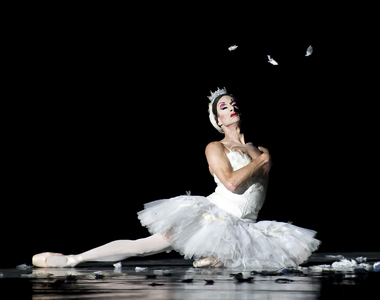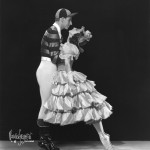
Les Ballets Trockadero de Monte Carlo's prima ballerina assoluta Ida Nevasayneva in 'The Dying Swan' (photo: Gene Schiavone)
Looking back over this year’s ballet reviews, B2TP was struck by the number of references to dancers who are, as Luke Jennings gracefully puts it,”in the autumn of their careers.” One of “ballet’s great poignancies,” Jennings claims, is that “the essence and truth of performance … is so often achieved at the very point when the dancer’s body begins to fail.”
Other reviewers have not been so kind.
A few legendary ballerinas continued to delight their fans well into their 40’s, 50’s and even 60’s (Margot Fonteyn, Maya Plisetskaya, Alicia Alonso, and Nina Ananiashvili come to mind) but today’s standards of athleticism in ballet, better training – which is developing legions of young talent, hungry for and deserving of stage time – and budget cutbacks in practically all dance companies conspire to edge out those ballerinas whose hips are starting to creak and who can no longer hold their backs up in the famous Romeo and Juliet press up lift.
To give up the identity of oneself as a dancer is an awful thing…The retiring dancer and heartbroken lover are never more alike than when their relationships end… Ballet is perhaps the greatest romantic love affair in the world. Nothing can replace this heady state.
– Kevin McKenzie, from Nancy Upper’s ‘Ballet Dancers in Career Transition'(2004)
In Nils Tavernier’s engrossing (if slightly depressing) 2001 film on Paris Opera Ballet ‘Tout Près Des Étoiles,’ Elisabeth Platel comments on her own impending retirement, pointing out the rewards of a ballet career and the many things she has been grateful for along the way, but asks: “is that life?”
To Marie-Agnès Gillot on the other hand, dance has been more than just un métier:
J’aime la danse… Mais en fait je le vis. Le verbe aimer est trop faible… C’est plus fort qu’aimer… Vivre quelque chose tellement à fond que la vie quotidienne serait moins importante.
Selby Shwartz’ account of The Dying Swan as performed by Les Ballets Trockadero de Monte Carlo offers a finely detailed analysis of how the Trocks’ campy, slapstick interpretation of the 1905 Fokine solo, originally made famous – or rather, initially INHABITED – by Anna Pavlova, makes a political comment on the cruel – and therefore funny – disintegration of the ballerina’s body.
“The descent of the body as the costume falls apart is a kinetic and corporeal answer to the Platonic idea of ballet. If the ideal of the ballerina is a sylph-like swan, the Trockadero will take it too literally, and produce the material body of a bird. If the ideal of the ballerina is the suppression of any sign of aging, struggling, falling, or behaving in an unladylike way, the Trockadero will give you their oldest ballerina, falling on his ass.
– Selby Schwartz
The Trockadero Dying Swan is a wry, empathetic reminder that mortality is actually painful and awkward, not lightly borne away. It involves a whole process of achingly, creakingly falling out of the disciplines that have kept the body ‘up’: bodies that were supposed to represent lightness and grace have back spasms and need hip replacements. For ballerinas in particular, the injunction to remain desirable, without showing the sweaty efforts required to produce the temporary illusion of gliding effervescently across the stage.
– Selby Schwartz
It takes a man in drag, pathetically trying to salvage the moulting feathers of his costume, to illuminate the fact that a ballerina is nothing but a woman in drag – impersonating a swan, or a princess of a non-existent kingdom, a temple dancer in an India that never was, one of Apollo’s muses, or a superhero like the Bomb Squad ‘In the Upper Room’. Stepping off the stage permanently, therefore, can be a terrifying act for a ballerina who must, for the first time, confront the question of who she really is.



